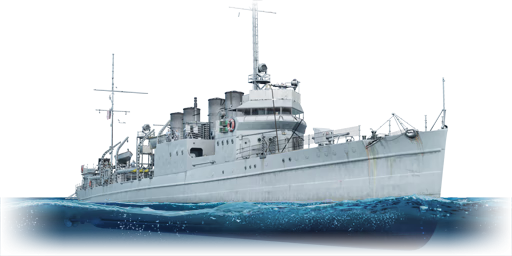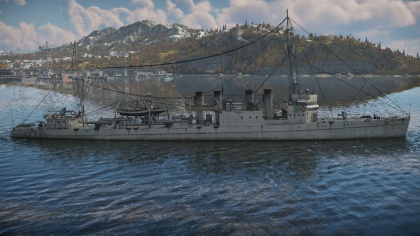USS Barker
Contents
Description
The Clemson-class, USS Barker (DD-213), 1942 is a rank I American destroyer
with a battle rating of 3.3 (AB/RB/SB). This destroyer was introduced in Update 1.79 "Project X" as part of the fleet closed beta test.
General info
Survivability and armour
The Clemson class is lightly armored and has an average crew size for a starter destroyer. The armor consists of 17mm of steel on the hull and 10mm of steel on the superstructure. At only 150 crew, the destroyer does not last long under fire, but the same can be said of the other starter destroyers. Additional armor is present on the gun mounts, but is otherwise absent. The Clemson class can endure against the smaller caliber guns found on torpedo boats and aircraft but is not able to stand up for long against other destroyers. There are some positives in the survivability, the guns are very hard to disable due to their small size and the layout having them spread out across the ship. 4 engines and 4 smoke stacks powering two transmissions makes it fairly hard to immobilize a Clemson. The fuel tanks are fairly small and only the rear ones are above the water line. The ammo racks are stored below the water line with the exception of the first stage, which are stored in the superstructure. The largest weak point is the bridge, which is very visible from all angles and very lightly protected.
Mobility
The Clemson's mobility and speed are nothing spectacular, it is actually quite slow among destroyers, but average for the starter destroyers. It is not exceptionally agile but is certainly capable of changing course to avoid torpedoes and high altitude bombs. The ability to change course abruptly will also help with overcoming the slow traverse of the primary armament.
Armament
Primary armament
Provide information about the characteristics of the primary armament. Evaluate their efficacy in battle based on their reload speed, ballistics and the capacity of their shells. Add a link to the main article about the weapon: {{main|Weapon name (calibre)}}.
Broadly describe the ammunition available for the primary armament, and provide recommendations on how to use it and which ammunition to choose.
Secondary armament
Some ships are fitted with weapons of various calibres. Secondary armament is defined by the weapon chosen with the control Select secondary weapon. Evaluate the secondary armament and give advice on how to use them. Describe the ammunition available for the secondary armament. Provide recommendations on how to use them and which ammunition to choose. Remember that anti-air armament, even heavy calibre weapons, belong in the next section.
If there is no secondary armament, remove this section.
Anti-aircraft armament
An important part of the ship’s armament responsible for air raid defence. Anti-aircraft armament is defined by the weapon chosen with the control Select anti-aircraft weapons. Talk about the ship’s anti-air cannons and machine guns, the number of guns and their positions, their effective range, and about their overall effectiveness – including against surface targets.
If there is no anti-aircraft artillery, remove this section.
Torpedo armament
Many ships are armed with torpedo launchers, and for some vessels such as boats, torpedoes are an extremely important means of defeating an opponent. Evaluate the position of the torpedo launchers, discuss the ammunition available, firing specifics such as dead zones, features of the torpedoes themselves, etc.
If there is no torpedo armament, remove this section.
Special armament
Depth charges, mines, rocket launchers and missiles are also effective in skilled hands and can be an unexpected surprise for an opponent. Evaluate the ammunition of this type of armament and rate its performance in combat.
Usage in battles
Describe the technique of using this ship, the characteristics of her use in a team and tips on strategy. Abstain from writing an entire guide – don’t get try to provide a single point of view, but give the reader food for thought. Talk about the most dangerous opponents for this vehicle and provide recommendations on fighting them. If necessary, note the specifics of playing with this vehicle in various modes (AB, RB, SB).
Modules
| Tier | Seakeeping | Unsinkability | Firepower | |||
|---|---|---|---|---|---|---|
| I | Dry-Docking | Tool Set | 4inch SP Common | Anti-Air Armament Targeting | ||
| II | Rudder Replacement | Fire Protection System | Smokescreen | 3inch Common Mk.3 | Auxillary Armament Targeting | |
| III | Propeller Replacement | Ventilation | Shrapnel Protection | Primary Armament Targeting | Improved Rangefinder | |
| IV | Engine Maintenance | New Pumps | Ammo Wetting | Torpedo Mode | ||
Pros and cons
Pros:
- Six torpedoes per side
- Turret traverse is decent compared to other first-generation destroyers
- Decent firing arcs
- Single 20 mm per side offers a minor degree of anti-aircraft protection
Cons:
- Slow shell velocity and rate-of-fire. This also makes aiming difficult at long ranges
- Extremely poor anti-aircraft protection. Single 20 mm is easy for enemy pilots to avoid
- No Armor
- Firepower is woefully inadequate for dealing with later destroyers
History
Laid down in April 1919, the USS Barker was part of the second production batch of the Clemson-class destroyers. She was completed by September of the same year and entered service with the U.S. Navy in December. In the interwar period, USS Barker visited several Turkish and Middle Eastern ports, before joining the Asiatic Fleet in the early 1920s. She cruised the Asiatic waters as well as performing patrols off the coast of Nicaragua before carrying out several visits to European ports in the late ‘20s. USS Barker was kept in the Asian theatre as part of the Asiatic Fleet until 1941, when the United States officially entered WW2 following the Pearl Harbour raid.
At the time of the raid on Pearl Harbour, USS Barker had been stationed on Borneo. Following the outbreak of hostilities between the U.S. and Japan, Barker undertook several patrol and escort missions around Borneo and the Dutch East Indies. Patrol and escort duties comprised most of USS Barker’s routine whilst stationed in the Pacific. In 1943 however, USS Barker was assigned to the Atlantic theatre as part of a hunter killer group. Despite this, the USS Barker rarely engaged in direct combat. Instead, she’s defined by her efforts of saving the lives of dozens of German sailors, who were lucky enough to survive the sinking of their vessel. From 1944 until the end of the war, Barker was mostly relegated to convoy escort duties in the Caribbean and Newfoundland. After the end of WW2, USS Barker was decommissioned and sold for scrap in November 1945, marking the end of her 26-year service period.
- From Devblog
Media
An excellent addition to the article will be video guides, as well as screenshots from the game and photos.
See also
Links to the articles on the War Thunder Wiki that you think will be useful for the reader, for example:
- reference to the series of the ship;
- links to approximate analogues of other nations and research trees.
External links
| USA destroyers | |
|---|---|
| Clemson-class | USS Welborn C. Wood · USS Barker · USS Litchfield |
| Farragut-class | USS Aylwin |
| Bagley-class | USS Bagley |
| Porter-class | USS Porter · USS Phelps · USS Moffett |
| Somers-class | USS Somers · USS Davis |
| Fletcher-class | USS Fletcher · USS Bennion · USS Cowell |
| Allen M. Sumner-class | USS Sumner |
| Gearing-class | USS Gearing · USS Frank Knox |
| Mitscher-class | USS Mitscher · USS Wilkinson |





